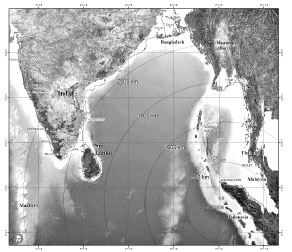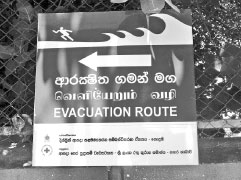|
Six years after 2004 tsunami:
Indian Ocean countries more prepared now
By Pramod DE SILVA
As the golden sun set on the distant horizon, waves gently lapped at
my feet. It was a tranquil setting on a secluded beach at Nilaveli,
Trincomalee. The sea looked calm, motionless almost. Can life always be
this serene?
 |
|
A tsunami buoy being
deployed |
 |
|
A tsunami warning tower |
One could hardly imagine this as the very same ocean that unleashed
its fury in the form of massive waves exactly six years ago. Way back
then, not many people even knew the term 'tsunami', which is Japanese
for 'massive wave'. In fact, in our collective conscience, a tsunami was
something that hit the distant shores of Japan and Hawaii, not our lands
in the Indian Ocean.
How wrong could one be? The Indian Ocean tsunami of December 26, 2004
was one of the biggest tsunamis ever in history. To be exact, it was one
of the biggest natural disasters ever. Nearly 40,000 people in coastal
areas around Sri Lanka perished and 550,000 were rendered homeless by
the tsunami, caused by a gigantic 9.3 undersea earthquake off the island
of Sumatra, Indonesia.
Sri Lanka, of course, was only one of the 14 countries affected -
Indonesia saw the largest number of casualties in Aceh and elsewhere,
while Thailand and India also suffered loss of lives and property as
30-metre high waves pounded the coastlines. Several countries in Africa
such as Somalia were also hit as the tsunami fanned out and dissipated.
The final (Indian Ocean-wide) death toll was well over 230,000.
Collective memory
The word 'tsunami' is now deeply embedded in our collective memory,
along with its sheer ferocity and tragic consequences.
It would not be incorrect to say that coastal residents still live in
fear of another tsunami. It's always there, in the deep recesses of
their minds. The word has also left its mark in the lexicon - we now
hear of words such as 'economic tsunami' and 'political tsunami'.
Such a large-scale disaster happened because the Indian Ocean
countries were totally unprepared for a tsunami. There was, in fact, a
gap of a few hours between the undersea eruption and the impact of waves
on shore, but no one heeded the warnings issued by the US Pacific
Tsunami Warning Centre in Hawaii. The result was that countries such as
Indonesia, Sri Lanka, Thailand and India practically woke up to a
tsunami.
Coastal residents (and tourists) were taken by surprise as the waves
hit the shore. Most of the victims were women and children, who could
not run as fast as adult males.
The initial response was chaotic to say the least - the authorities
and residents were equally dumbfounded and inactive. Only when the full
horror of the cataclysm unfolded did they spring into action. But it was
too late for more than 200,000 people and their families.
 |
|
Map depicting the
tsunami's impact |
It was a human tragedy on an unprecedented scale. Whole families were
wiped out. Many children lost their parents and vice versa. Millions of
houses were reduced to rubble, leaving the occupants who survived the
onslaught of waves only with the clothes they were wearing. Six years
later, the scars of the tsunami, physical and mental, still remain.
It was undoubtedly a tragedy of the highest proportions, but it was
also a lesson for humanity. Here in Sri Lanka, we were moved by the
massive outpouring of sympathy for the victims regardless of ethnic and
religious divisions. It was a moment that symbolised the strong bonds of
friendship and unity among all communities. All political parties forgot
their differences and joined hands to rebuild the country.
The tragedy also triggered an outpouring of shock and grief all over
the world and aid started flowing very quickly. It was an unprecedented
humanitarian response both within the affected countries and
internationally. More than US$ 14 billion was pledged for recovery,
rehabilitation and reconstruction efforts in the affected countries.
Indian Ocean countries have made it a point to 'build back better'
after the devastation of the 2004 tsunami. Coastal communities have
sprung back to life as governments have tried their best to rehabilitate
their shattered lives and rebuild their homes, schools, hospitals and
places of worship. Fishery communities, among the worst affected, are
now back at sea with better boats and equipment.
For example, the UN said last week that Indonesia's Aceh province has
made a "remarkable" recovery after the devastating 2004 tsunami, but
many serious challenges remain. A UN Development Program report said
rebuilding had been impressive in Aceh. Sri Lanka's rebuilding efforts
have been similarly praised by the international community.
The question is, when will another tsunami strike the region? There
have been frequent earthquakes in the Sumatra fault line over the last
six years and minor tsunamis as well. It is only a question of time
before a mega quake or tsunami hits the region.
But we cannot predict the next big one - it can be tomorrow, next
year or in 2050. The best approach is to be prepared for any
eventuality.
 |
|
All countries have marked tsunami
escape routes |
This is where it gets complicated, as earthquakes cannot be predicted
with any accuracy. But the damage they cause can be controlled if action
is taken to immediately notify residents. This is the challenge facing
Indian Ocean countries.
Wake-up call
The 2004 tsunami was thus a wake-up call to Indian Ocean countries.
Six years on, they are clearly more prepared to face a tsunami. The
region is now covered by the Indian Ocean Tsunami Warning System built
with UNESCO and German help. Twenty-six national tsunami information
centres, capable of receiving and distributing tsunami advisories
round-the-clock have been set up in Indian Ocean countries.
The seismographic network has been improved, with 25 new stations
being deployed and linked in real-time to analysis centres. The system
basically employs high-technology deep sea buoys to pinpoint the depth
and strength of movements on the seabed. The system is also in touch
with the tsunami warning centres in Hawaii and Japan, which makes it a
worldwide warning mechanism.
There are also Deep-ocean Assessment and Reporting of Tsunamis (DART)
sensors. Important additional equipment including instruments such as
deep-sea pressure sensors and satellites are also available. Individual
countries are also taking their own steps - Thailand recently deployed
additional tsunami-detecting buoys off Phuket.
Any information on a tsunami is relayed by tsunami warning towers
equipped with high decibel sirens. Moreover, mobile operators have
agreed to send warnings by text, while radio and television stations
will also update the tsunami status every minute. This should provide
ample time for residents to leave the coast for higher ground and for
authorities to take any other necessary measures.
All countries have marked tsunami escape routes in coastal areas and
regularly conduct tsunami drills. Thailand and Sri Lanka conducted
tsunami drills last week. Sri Lanka also observes the National Safety
Day every year on December 26. This year's event will be held today in
Jaffna. Two minutes' silence will be observed in remembrance of those
who perished in the disaster. The people of the Maldives will also step
onto the streets at the same time on Sunday to remember the devastating
tsunami that struck several Indian Ocean nations six years ago. Maldives
also marks the event as National Unity Day.
Coastal communities
Involving coastal communities in these endeavours is crucial. In a
report commissioned by the five countries hit hardest by the disaster
(Sri Lanka, Indonesia, Thailand, India and the Maldives) and presented
to the United Nations, it was recommended that involving local
communities in the recovery process is as instrumental as installing
high-tech early warning systems. The report also highlighted the need
for governments to incorporate disaster-risk reduction measures in
national development plans.
 |
|
Tsunami waves hitting
Kalutara beach |
There are other lessons as well. Many countries including Sri Lanka
now limit constructions near beaches. Enhanced efforts are under way for
coast conservation. Countries which have protected their mangroves, such
as Bangladesh, suffered remarkably minor damage. Hundreds of thousands
of hectares of mangroves - many of which had been cleared for shrimp and
fish farms - were replanted in Indonesia, Sri Lanka and Thailand after
experts said they could have provided a barrier to slow down the waves.
Yet, the final hurdle will be very difficult to overcome. While the
physical rubble has long been cleared, the emotional debris is likely to
remain. Effacing these memories will be the biggest challenge of all.
Coastal dwellers will continue to fear the sea, on which most of them
depend for a livelihood.
The loss of loved ones cannot be effaced from the minds of survivors,
even if they have got brand new houses and other comforts. It will be a
tragedy they want to forget, but simply cannot.
As a nation and a region, we cannot ever forget the massive
destruction caused by the tsunami. It is also impossible to forget its
emotional fallout. Nevertheless, it is prudent to learn vital lessons
from the Indian Ocean Boxing Day tsunami to face any such natural
disaster in the future.
Nature is unpredictable, but we could evolve swift and effective
responses to natural calamities to minimise the disastrous effects on
life and property.
|

